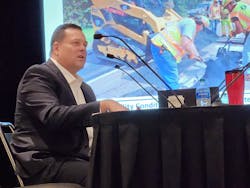6 Tips for Communicating with the C-Suite (IFMA 2023)
Communicating with the decision-makers in the C-suite isn’t just a challenge—at times, it may seem like facilities professionals are speaking another language. In some ways, they are. But it’s possible to learn to speak the same language as the C-suite to make the business case for facility improvements in a way the decision-makers can relate to.
A Crossfire-style panel at IFMA’s 2023 World Workplace conference demonstrated where communication gaps often occur—and what you can do about them. Sharing their expertise were:
- Gary Walker, senior director of facilities management for Seattle Children's Hospital
- Skip Vaughn, director of the Office of Facilities & Property Management for the National Institute of Standards & Technology (NIST)
- Kyle Lester, senior vice president of maintenance, Denver International Airport, for the City and County of Denver Department of Aviation
- Scott Newell, CEO of K-12 planning firm Cooperative Strategies; previously, division director for the Office of Capital Construction at the Colorado Department of Education
How FMs and Executives Speak
The main communication issue crops up in the way facilities professionals think about FM, suggested panel moderator Eric Dillinger, strategic consulting sector leader and corporate strategy advisor for Woolpert, a consulting services firm.
When your job is to manage facilities and equipment, you often think about products or services in terms of features—facts that add credibility and substance to your message, like the age of a piece of equipment or the size of a building. However, members of the C-suite think in terms of benefits—ways that products or services add value to the organization, such as cost savings, risk reduction, or public perception. Communicating using benefits instead of features helps translate your FM message to the C-suite.
In addition, facilities managers often speak in terms of conditions, such as your Facility Condition Index score, the air quality index, or the amount of deferred maintenance you need to catch up on. To explain why the C-suite needs to invest in an upgrade or replacement, you need to frame it in terms of consequences—loss of service or value, compliance risks, degraded performance, or even death.
How to Make Your Case
The panel shared real-world stories of how they’ve managed to get projects funded at their organizations, including these six actionable tips.
1. Quantify what you already know. NIST receives its funding from Congress, a group that can be hard to convince at the best of times. Vaughn described the way NIST scientists were constantly forced to find workarounds for failing equipment and facilities. Ultimately, the agency started surveying the scientists across buildings old and new about how much time they were wasting and translated that into dollars wasted—to the tune of over $230 million per year of wasted labor. “Give me the money to renovate a building or build a new research building. The ROI is less than five years,” Vaughn said. “That suddenly got the appropriator’s ears.”
2. Describe the mission impact. NIST found success in talking about external impacts—ways issues at NIST could negatively impact other agencies. One of NIST’s tasks is to calibrate and certify medical devices that use radiation. “If this building goes down, every device in the U.S. will be decertified,” Vaughn explained. Tell your stories about how facilities’ failures will impact others.
“Our mission is serving our passengers and excellence in operations for our airline partners,” Lester said of Denver International Airport. “We have to drive that point. …When assets run to failure, what’s the lead time on replacement? Operations are down for this amount of time. This is the revenue that will be lost because operations are down. That’s what drives the point home.”
3. Do your due diligence to sell the argument. In his former position with the Colorado Department of Education, Newell found that the state legislature asked most about enhancing educational outcomes in the state. “We reported out, based on our due diligence, here’s where we’re seeing air quality effects that impact absenteeism and retention,” Newell said.
4. Make sure you’re covered when you propose new technologies. Smart building tech promises to save money, time and hassle—but if your staff doesn’t know how to operate it and wants to continue operating things manually, you won’t get the savings you promised the C-suite. “If you’re making comments about ‘This is how much money we’re going to save’ and you don’t, whose neck is on the line? Yours,” Vaughn said. Before you even propose the investment, do your homework and make sure your staff can come along with you.
5. Stack dollars to meet multiple objectives at once. “Sometimes doing one thing will also get a second thing. Every time you save energy, I’ll guarantee you, you reduce carbon,” Dillinger said. “A dollar of energy savings has a carbon tail to it every time.”
Look for strategic upgrades to meet more than one objective, Dillinger advised. Bring the same story, but tailor it to people with different interests.
6. Know what your C-suite values. Some organizations could care less about sustainability and others view it as a powerful part of their brand. “Target your messaging to what the C-suite cares about,” Vaughn said.
When facilities professionals and the C-suite can communicate clearly, the value of facilities managers—and the value of maintaining physical facilities—becomes clearer to decision-makers. Honing your communication skills can only help your facilities team.
About the Author
Janelle Penny
Editor-in-Chief at BUILDINGS
Janelle Penny has been with BUILDINGS since 2010. She is a two-time FOLIO: Eddie award winner who aims to deliver practical, actionable content for building owners and facilities professionals.

